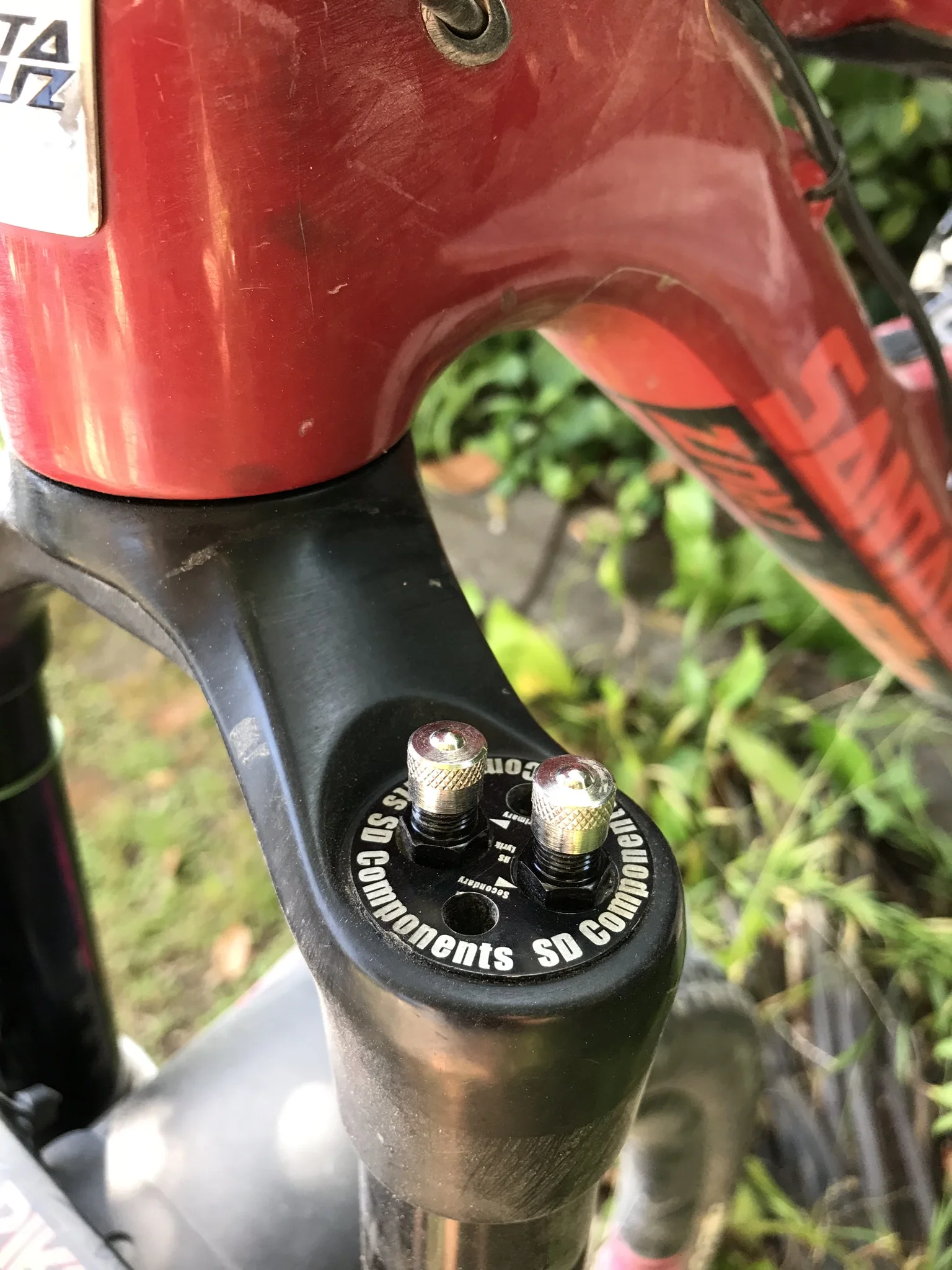Once in a while an add-on product comes along that is so simple yet hugely increases the performance of the device it is attached to and you wonder why no one thought of it earlier. Well people had thought of this neat concept earlier and we have seen similar built into other products like the Ohlins RFX fork, but it took a smart guy like Simon Duong from SD Components to invent a trick little unit which very easily retro-fits into your 35mm Rockshox or 36mm Fox fork.
It replaces your existing air top cap
Meet my new best friend, the DVC. Hang on…is this a review or is therodfather sucking up to another freebie?.... Who cares? This little thing has transformed my ride and I want one in all my forks as of yesterday…... So what the hell is it?
It’s a top cap that replaces your existing top cap on the top of your air cartridge. It has a tube attached to it that holds a volume spacer. Whoop de doo! Just hang on… This volume spacer slides up and down in the tube and extends its volume from one spacer to the same as about four spacers and it does this automatically at a speed depending on how much air pressure you put into it. Head hurting yet?
Do you even understand what your air cartridge looks and works like? Let me explain. Your unit is just like a syringe (with your finger plugging the needle hole). Push on the fork/plunger and the main chamber compresses and the pressure increases. You can’t push it all the way in as the air has no where to go. This has been a problem for fork manufacturers for ever…how big to make that main chamber so that you get full travel, but at the end of that travel it slows down firmly to give a good “ramp up” and “bottom out control”. Too much volume and the fork will bottom out harshly. Too little volume and you’ll never get full travel or your fork will have to run too soft to do so.
This is why forks now have a main chamber that is a smidgen too large so we can fine tune the ramp up by making it smaller ourselves (by adding volume spacers under our top cap). The problem with this concept is that it requires a lot of pissing about and you have to experiment every time you want to change the forks characteristics for different trail types and riding styles. Also more spacers added means more ramp up, so you may have to drop your air pressure which means you’re changing the whole length of your forks compression stroke behaviour.
My stock air cap on left with 4 volume spacers to show the similar size to the DVC on right
What is genius about the DVC system though is that as you must run more pressure in the DVC than the main chamber, it remains static until the main chamber pressure is increased (by a bump force) until it equalizes the DVC pressure, then the DVC piston starts to move and reduces in volume giving a less aggressive ramp up which gives a feeling of bottomless travel with a less harsh bottom out... the DVC allows you to fine tune the end stroke ramp up independently from the main air spring. Phew!
Still confused? Let me give you some examples. (note: figures shown here are just figurative...I don't want any of you tech nerds giving me grief about my pressure settings)
With my Pike fork as standard with no volume spacers I run about max 80psi to still get full travel and then there is about 4 volume spacers worth of air left in the cartridge which is a bit spongy and will bottom out harshly on a big hit. With 3 volume spacers installed I run it at about 65psi to get full travel and then there is only one volume spacer worth of air left which is obviously at a much higher pressure. This means a much softer fork initially with a shorter mid stroke and a stronger end ramp, which is great but does shorten the usable travel just riding along as the end ramp comes into effect much earlier.
But with the DVC I can run it even softer…like 55psi. This would normally mean a harsh bottom out or add even more spacers, but then the air chamber would run out of room. But now I can run the DVC chamber at 75psi. This means that as the fork compresses and the main chamber pressure increases the DVC behaves like a 4 spacer unit. When it gets to 75psi the DVC piston starts to move but slower than the main piston as it had a higher psi to start with, and it’s smaller, so ramps up quicker. Eventually the pressure in the DVC is so great that it slowly arrests its travel at near full compression…like jumping on a mattress, as opposed to a concrete floor with a fixed volume spacer. Then I can make it even firmer by running 85psi..or what about 95psi? The tuning options are virtually limitless. Are you impressed yet? And you can do it in 30 seconds with a shock pump. As you may have guessed it allows you to run ridiculously low main chamber air pressures for super plush small bump compliance but still handle big hits.
What is a huge bonus though is that that mystical mid stroke wallow can be controlled a hell of a lot better by manipulating both pressures to suit.
It’s important to note that with the 2015-2017 Fox 36, you need a small modification to your air shaft. It’s best to chat to SD Components about this but it can be done by your LBS (as long as they don't double as a lawnmower shop also).
The base of the DVC. You can see the floating piston which I have push in about 20mm, which is what happens when the main air chamber pressure becomes the same as the DVC pressure and it starts to decrease in volume...so simple...so RAD!
Yeah I know....I'm just confusing you more...here, a picture or four speaks a thousand words....
ABOVE: A diagram of the fork cartridge just waiting for action
ABOVE: As the fork compresses the main chamber decreases in volume and pressure builds but the DVC won't move until the main chamber pressure reaches the DVC pressure
ABOVE: When main chamber reaches the DVC pressure, the floating piston moves reducing the DVC volume
ABOVE: At near full compression the DVC volume is at its minimum giving a plush and seamless ramp up to full travel. The more pressure you started with in the DVC means a stronger, slower end ramp
Do I need to go into a ride characteristic review? No! There are so many reasons to upgrade your fork with this unit, here’s 10 good ones.
1. Your fork rides like shit
2. You’re very heavy or very light
3. You’re a bike pimp freak
4. You struggle to set your fork up to suit you
5. You own a Rockshox 35mm or Fox 36mm
6. You believe the dribble that spews forth from therodfather
7. You’ve run out of cool things to Instagram
8. You suffer from FOMO
9. You want the best
10. You love buying stuff on the Net.
Look, I know I've confused the f*** out of most of you. But give me a break..If I was smart enough to explain this properly I wouldn't be sitting at home on my laptop earning zilch dolleros for a mammoth two days work now would I? Luckily I have top notch tech nerds at my disposal...guys like Dougal from Shockcraft Suspension who actually finished school and got a real job....he also is the NZ agent for SD Components so I got him on the blower for a proper explanation (we could have texted each other but we're both over 30)...take it away Dougal....
"The DVC splits it into two dynamic chambers. Valve on the bottom one sets initial compliance, valve on the top one sets end-stroke progression. The balance between the two gives you tunable mid-stroke support."
OR if you're really thick like me and had to ask for an easier explanation...
"One valve sets for small bumps, the other valve sets for big bumps"
Thanks Dougal.
The DVC will fit any 35mm Rockshox or 36mm Fox fork .I have a Luftkappe on my main piston too...so there's heaps of room
Out on the trail... Well, the initial compliance from the gizmo radialised into a dynamic midstroke on medium to big hits with a linear yet progressive ramp up that had me yearning for a peanut butter sandwich. Climbing was outrageous and descending was so much better with the added protein..... Look , if you're not convinced by the tech talk already then why on earth would you give a toss about how a washed up wannabe enduro whatever is gonna spout on about how it rides. IT'S JUST BLOODY GOOD. Your Pike/Yari/Lyrik/Boxxer/Float36 fork is now able to be tuned to change your initial stroke force independently from your end stroke ramp up, and if you play around with the pressure differences you can shorten/lengthen your mid stroke ramp up... who cares what the hell I thought it rode like?
If you want one just call the #midstrokebusters at Shockcraft Suspension but first jump on the SD Components website to have a gander.
It may seem a little pricey at $349NZD but it's an incredible upgrade that works way better than I ever expected..and you can fit it yourself.
THE GOOD: Incredible performance tuneable in seconds. Looks super RAD and PRO. Everyone can see it therefore realise how RAD you are.
THE BAD: Costs more than a coffee. You can't bodge one up yourself in the garage
THE UGLY: Once you ride one you'll want one for every other bike in the shed.
Like any good pro rider I have my settings written somewhere so when I fettle I can remember where I started. I write other important notes on there too. #dementiasucks










